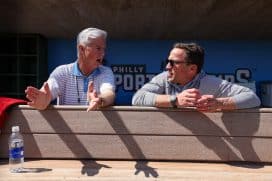Uncategorized
Snider Left Flyers Legacy in Good Hands
April 11, 2016 will always be remembered as a sad day in Philadelphia sports history; the day that the Flyers, the city, the NHL and the entire hockey world lost Ed Snider to cancer at age 83. He was more than just an owner. He was an icon of self-made success, toughness balanced by compassion and of a willingness to take calculated risks to follow one's dreams.
However, in the greater sense, it is fitting that Ed Snider departed this earth free of suffering, able to see how beloved he was by countless people and, perhaps most poignantly given his passion for the Philadelphia Flyers, seeing the team triumphant in the goal of reaching the 2016 Stanley Cup playoffs without sacrificing the assets that promise to make for an even brighter future.
On Saturday afternoon's home finale, even before Wayne Simmonds (among other players) publicly dedicated the must-win game to Snider and then went out and scored two goals in a 3-1 triumph over a scaled-down version of the Pittsburgh Penguins to clinch a playoff spot, there was already a sense that it was going to be a memorable day for the Flyers. Detroit and Boston both lost their earlier afternoon games. The Flyers, boasting a strong home record, were sure to have motivation and emotion on their side.
Lauren Hart's spontaneous decision to Face-time her powerful rendition of "God Bless America" — the duet version with Kate Smith on video from Game 6 of the 1974 Stanley Cup Final — so that lifelong family friend Snider could watch her sing it directly to him as well as to sold-out crowd at Wells Fargo Center was one of most stirring and heart-wrenching moments of franchise history.
Even when the Flyers fell behind 1-0 early and seemed a bit jittery and off their game, there was still an indescribable sense of calm that things would be OK. When Steve Mason authored a spectacular and potentially season-saving glove stop late in the first period and the Flyers came right back for Simmonds to score the first of his two goals, the feeling grew.
The Flyers postgame locker room was an emotional place after Saturday's game. Player after player spoke from the heart about how much it meant to them not only to be in the playoffs but to do it for the franchise's co-founder and chairman of a half-century. During the interviews, I could not help but take a couple of glances up to the Snider portrait that hangs in the locker room beside the other figures from franchise history that have been inducted in the Hockey Hall of Fame. It does not stand alone in the room. It is surrounded by many others who shaped the team. That was how Ed Snider himself wanted it. The focus was always on the team.
Even Sunday's otherwise meaningless game was important in one sense. It was another Flyers victory in Ed Snider's last day on earth. The Flyers finished the 2015-16 season with a statistical winning record on the road after going a dismal 10-20-11 on the road the previous year. In short, it was a sign of a team moving in the right direction as well as moving on to the playoffs.
During the first two seasons of Ron Hextall's tenure as general manager, he has been vehement about not deviating from a plan focused strongly on drafting and developing young talent rather than seeking quick-fix solutions to temporarily better the team's short-range playoff chances. The 2015-16 campaign was a smashing success in terms of a host of prospects in the system taking big strides in their development. Couple that with the current NHL squad making the playoffs, and this year's campaign seems destined to go down as one of both short-term triumph and long-range progress, regardless of whether there is a fairy tale ending in store for the playoffs this spring.
Ed Snider left the Flyers in good hands. The reason why Paul Holmgren — the only man who has been a player, head coach, general manager and, now, club president of the Flyers — was appointed club president was not just to "make room" for Hextall as GM. Rather, it was because Snider knew that Holmgren understands deeply what makes the Flyers the Flyers and the things that Snider himself valued so deeply. The torch of upholding and growing that legacy was specifically entrusted to Holmgren; a responsibility every bit as awesome as the task Hextall has in building a perennial contender.
Flyers' critics delight in taunting the franchise about the fact that it has not won a Stanley Cup since 1975. However, that criticism fails to recognize that decade(s)-long Cup droughts are part of all 30 NHL teams' franchise histories at different points. Even if one were to exclude the Flyers' two Stanley Cup championships, they have the NHL's second-highest winning percentage since 1975. They've made six additional trips to the Finals, and, with a few game-of-inches breaks here and there, just as easily could have won as lost the 1980, 1987 and 2010 Finals. If one looks only at the past 21 NHL seasons, only the Detroit Red Wings (an extraordinary 21-for-21) have surpassed the Flyers' 18 playoff appearances.
Hockey people would tell you that the latter group of measurements is every bit as important to franchise success as winning the Cup. That's because the Cup cannot be traded for, bought in free agency or even drafted. It takes luck as well as design to take that final step.
The bottom line is that Ed Snider presided over an extremely successful franchise with a brand that is recognized throughout the sports world, including among those whose loyalties are to other franchises but admit their grudging respect or who are not even hockey fans. He created an indelible legacy and put good people in charge of seeing it maintained and grown.
Bill Meltzer is a columnist for Flyerdelphia. Follow him on Twitter @billmeltzer.












































